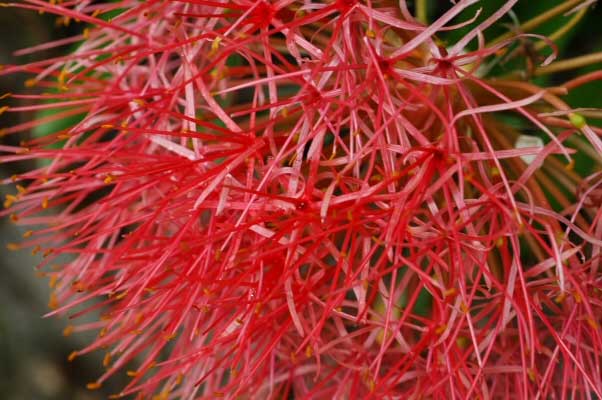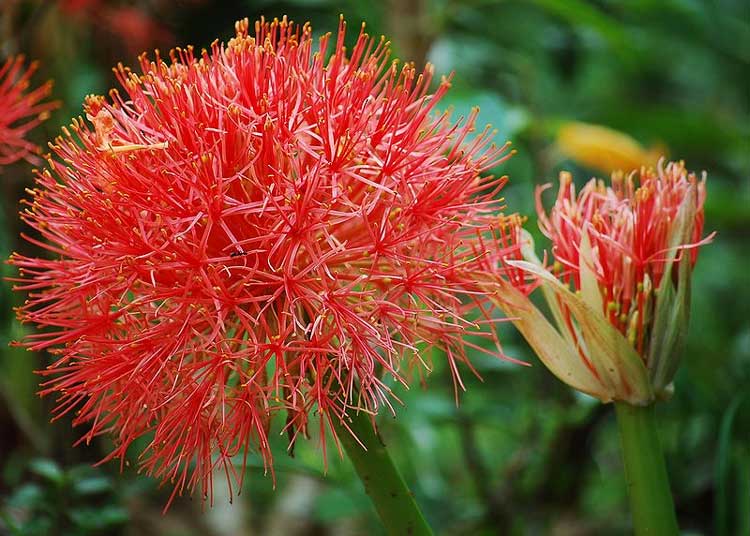
Scadoxus multiflorus (*)
Classification System: APG IV
Superregnum: Eukaryota
Regnum: Plantae
Cladus: Angiosperms
Cladus: Monocots
Ordo: Asparagales
Familia: Amaryllidaceae
Subfamilia: Amaryllidoideae
Tribus: Haemantheae
Genus: Scadoxus
Sectio: S. sect. Scadoxus
Species: Scadoxus multiflorus
Subspecies: S. m. subsp. katherinae – S. m. subsp. longitubus – S. m. subsp. multiflorus
Name
Scadoxus multiflorus (Martyn) Raf., Fl. Tellur. 4: 19 (1838).
Synonyms
Basionym
Haemanthus multiflorus Martyn, Monogr.: s.p., t. (1795).
Homotypic
Amaryllis multiflora (Martyn) Tratt., Ausw. Merkw. Gartenpfl.: 37 (1821).
Nerissa multiflorus (Martyn) Salisb., Gen. Pl.: 131 (1866), comb. inval.
Distribution
Native distribution areas:
Continental: Africa
Regional: West Tropical Africa
Benin, Burkina, Ghana, Guinea-Bissau, Guinea, Ivory Coast, Liberia, Mali, Mauritania, Nigeria, Senegal, Sierra Leone, Togo.
Regional: West-Central Tropical Africa
Burundi, Central African Republic, Cameroon, Congo, Equatorial Guinea, Gabon, Gulf of Guinea Islands, Rwanda, Zaire.
Regional: Northeast Tropical Africa
Chad, Djibouti, Eritrea, Ethiopia, Somalia, Sudan.
Regional: East Tropical Africa
Kenya, Tanzania, Uganda.
Regional: South Tropical Africa
Angola, Malawi, Mozambique, Zambia, Zimbabwe.
Regional: Southern Africa
Botswana, Cape Provinces, Namibia, KwaZulu-Natal, Swaziland, Northern Provinces.
Regional: Western Indian Ocean
Chagos Archipelago (introduced), Seychelles.
Continental: Asia-Temperate
Regional: Arabian Peninsula
Oman (doubtfully present), Saudi Arabia, Yemen.
Continental: Northern America
Regional: Mexico
Mexico Central, Mexico Gulf (introduced).
Continental: Southern America
Regional: Caribbean
Trinidad-Tobago (introduced).
References: Brummitt, R.K. 2001. TDWG – World Geographical Scheme for Recording Plant Distributions, 2nd Edition
References
Govaerts, R. et al. 2021. Scadoxus multiflorus in World Checklist of Selected Plant Families. The Board of Trustees of the Royal Botanic Gardens, Kew. Published on the internet. Accessed: 2021 Sep 7. Reference page.
Vernacular names
English: Blood lily
português: Flor de Natal

Scadoxus multiflorus (*)
Scadoxus multiflorus (formerly Haemanthus multiflorus) is a bulbous plant native to most of sub-Saharan Africa from Senegal to Somalia to South Africa. It is also native to Arabian Peninsula (Saudi Arabia, Yemen, Oman) and to the Seychelles. It is naturalized in Mexico and in the Chagos Archipelago.[1]It is also found in Indian peninsula. It is grown as an ornamental plant for its brilliantly coloured flowers, either in containers or in the ground in where the climate is suitable. There are three recognized subspecies. Strongly toxic like other Scadoxus species, it has been used as a component of arrow poisons and fishing poisons, as well as in traditional medicine. Common names, some of which are used for other species, include blood lily, ball lily, fireball lily, blood flower, Katherine-wheel, oxtongue lily, poison root and powderpuff lily.[4]
Description
Scadoxus multiflorus subsp. multiflorus near Victoria Falls
Blood Lily -- Scadoxus multiflorus
Scadoxus multiflorus grows from a "rhizomatous bulb", i.e. a bulb which also produces rhizomes (modified underground stems). The leaves and flower may appear together or the leaves may be produced later. The bases of the leaves, the stalks or petioles, are tightly wrapped together to form a pseudostem or false stem, 5–60 cm (2–24 in) long. The flowers are produced in an umbel at the top of a leafless stem (scape), 12–75 cm (5–30 in) long. Both the pseudostem and the scape are often covered with reddish brown to dark violet spots. The bracts under the umbel soon wither.[5]
The umbel of flowers is more-or-less globe shaped, with from 10 to 200 individual flowers. Each flower has a stalk (pedicel) typically 15–45 mm (0.6–1.8 in) long. The tepals, filaments of the stamens and the style are all scarlet, fading to pink. The bases of the tepals are fused to form a cylinder-shaped tube, 4–26 mm (0.2–1.0 in) long; the free ends of the tepals are 12–32 mm (0.5–1.3 in) long, narrow and spreading. The fruit is a berry, 5–10 mm (0.2–0.4 in) across.[5]
Differences between the three accepted subspecies have been summarized by Friis and Nordal, and are shown in the table below.[6]
Difference between subspecies S. m. subsp. multiflorus S. m. subsp. katherinae S. m. subsp. longitubus
Length of flower tube 4–15 mm 12–22 mm 15–26 mm
Length of free segments of the flower 12–32 mm 18–30 mm 15–28 mm
Width of free segments of the flower 0.5–2.5 mm 2.2–4 mm 1.4–3.4 mm
Height Variable Up to 120 cm Up to 65 cm
Distribution Southern to tropical Africa; Arabia Swaziland; eastern coastal South Africa Lowland forest in tropical west Africa
It can be seen that although the dimensions mostly overlap, the length of the flower tube relative to the free segments at the end of the flower distinguishes S. m. subsp. longitubus, in which they are more-or-less the same length, from S. m. subsp. multiflorus, in which the tube is generally shorter than the free segments. S. m. subsp. katherinae is intermediate. S. m. subsp. multiflorus tends to have narrower free segments than the other two subspecies. S. m. subsp. katherinae is tall, S. m. subsp. longitubus short, with S. m. subsp. multiflorus generally intermediate, although varying in height throughout its considerable range.
Taxonomy
Scadoxus multiflorus was originally described by English botanist Thomas Martyn in 1795 as Haemanthus multiflorus. Constantine Samuel Rafinesque moved Haemanthus multiflorus to his new genus Scadoxus in 1838, giving it its current binomial name Scadoxus multiflorus.[1][7] The separation of Scadoxus from Haemanthus was ignored by most workers until 1976, when the two genera were again segregated by Ib Friis and Inger Nordal. Haemanthus species are southern in distribution, form true bulbs and have 2n = 16 chromosomes, whereas Scadoxus species, such as S. multiflorus, are found throughout tropical Africa, do not all form bulbs and have 2n = 18 chromosomes.[8] The leaves are a further distinguishing characteristic: those of Scadoxus are thinner and have a distinct stalk (petiole); those of Haemanthus are thicker and without a petiole.[8]
Scadoxus multiflorus subsp. multiflorus in Arusha National Park, Tanzania
Subspecies
Three subspecies are known:[2]
S. multiflorus ssp. katharinae (Baker) Friis & Nordal – Swaziland and eastern South Africa
Synonyms: Haemanthus katharinae Baker, Haemanthus multiflorus subsp. katharinae (Baker) I.Bjørnstad & Friis
S. multiflorus ssp. longitubus (C.H.Wright) Friis & Nordal – west Africa
Synonyms: Haemanthus longitubus C.H.Wright, Haemanthus multiflorus subsp. longitubus (C.H.Wright) I.Bjørnstad & Friis, Haemanthus mannii Baker
S. multiflorus ssp. multiflorus – tropical and southern Africa, the Arabian Peninsula
Distribution and habitat
The species is native to tropical and southern Africa and parts of the Arabian Peninsula. Only the subspecies S. m. subsp. multiflorus occurs throughout this range. it is primarily a plant of moist, shady habitats. S. m. subsp. longitubus is found only in tropical West and Central Africa, in moist lowland forest in Ghana, Ivory Coast, Liberia and Sierra Leone as well as in Cameroon. S. m. subsp. katherinae is native to Mediterranean climate forest, scrub and woodland in eastern southern Africa – Cape Province and KwaZulu-Natal in South Africa and Swaziland.Called 'May masa poovu' meaning May flower in malayalam as it blooms in the month of May, it can also be found in southern parts of India, especially Kerala.
Cultivation
Scadoxus multiflorus is not frost-hardy and must be kept at a minimum temperature of 5 °C (41 °F), for forms of southern African origin, up to 10 °C (50 °F) or more for those of tropical origin. An open, well-drained growing medium, largely organic in nature, is recommended.[9] Propagation is by seed. Pests are those of Scadoxus generally.[9][10]
Scadoxus multiflorus subsp. longitubus is rarely if ever cultivated,[9] although (under the synonym Haemanthus mannii) it was described as having been "introduced" in 1877.[11] Scadoxus multiflorus subsp. multiflorus is produced for sale in large numbers by the Dutch horticultural industry. In cultivated forms, the flowers often appear before the leaves, sometimes not until late summer.[9]
Scadoxus multiflorus subsp. katherinae has been described as "imposing",[9] sometimes reaching a height of 120 cm (4 ft), with a strong purple-spotted pseudostem. Red berries may be produced, which can last through the winter. The UK National Plant Collection for Scadoxus has described it as "an excellent plant for a glasshouse or sunny windowsill."[9] In South Africa it can be grown in the open garden in the shade, in well-drained, light soil containing plenty of organic matter. It requires ample water when in growth but must have good drainage when dormant. It will grow under trees provided the soil is sufficiently fertile.[10]
Cultivars
Some artificial hybrids between S. multiflorus subsp. katherinae and S. puniceus are known. Johannes Nicolai raised S. 'König Albert' which flowered for the first time in 1899. Although rare in cultivation, it multiplies rapidly. Of the same parentage is S. 'Andromeda', raised by C. G. van Tubergen around 1904.[9]
Scadoxus multiflorus subsp. katherinae has received the Royal Horticultural Society's Award of Garden Merit.[12]
Toxicity and uses
The genus Scadoxus has some strongly toxic species, containing poisonous alkaloids lethal to animals, such as sheep and goats, that graze on the leaves or bulbs. Scadoxus multiflorus is traditionally used in parts of tropical Africa as a component of arrow poisons and fishing poisons. It is also used in traditional medicine, although in South Africa less so than Scadoxus puniceus.[10]
References
"Scadoxus multiflorus", World Checklist of Selected Plant Families, Royal Botanic Gardens, Kew, retrieved 2014-03-26
"Search for Scadoxus multiflorus", World Checklist of Selected Plant Families, Royal Botanic Gardens, Kew, retrieved 2014-03-26
"Scadoxus multiflorus", The Plant List: A Working List of All Plant Species, retrieved 2014-04-23
"Scadoxus multiflorus". Germplasm Resources Information Network (GRIN). Agricultural Research Service (ARS), United States Department of Agriculture (USDA). Retrieved 2014-04-23.
"Scadoxus multiflorus (Martyn) Raf.", eMonocot, retrieved 2014-04-04
Friis, I.; Nordal, I. (1976), "Studies on the genus Haemanthus (Amaryllidaceae) IV. Division of the genus into Haemanthus s. str. and Scadoxus with notes on Haemanthus s. str.", Norwegian Journal of Botany, 23: 63–77
Rafinesque-Smaltz, C.S. (1838), Flora Telluriana, Philadelphia, part 4, p. 19, retrieved 2014-03-25
Meerow, Alan W. & Clayton, Jason R. (2004), "Generic relationships among the baccate-fruited Amaryllidaceae (tribe Haemantheae) inferred from plastid and nuclear non-coding DNA sequences", Plant Systematics and Evolution, 244 (3–4): 141–155, doi:10.1007/s00606-003-0085-z
Hutchinson, J. (2007), "Scadoxus of South Africa", The Plantsman, New Series, 6 (1): 10–14
Scadoxus multiflorus (Martyn) Raf. subsp. katharinae (Bak.) Friis & Nordal, South African National Biodiversity Institute, retrieved 2014-03-25
Baker, J.G. (1888), "3. H. mannii Baker", Handbook of the Amaryllideae, including the Alstroemerieae and the Agaveae, London: George Bell & Sons, pp. 63–64, retrieved 2014-04-08
"Scadoxus multiflorus subsp. katherinae". RHS. Retrieved 5 March 2021.



